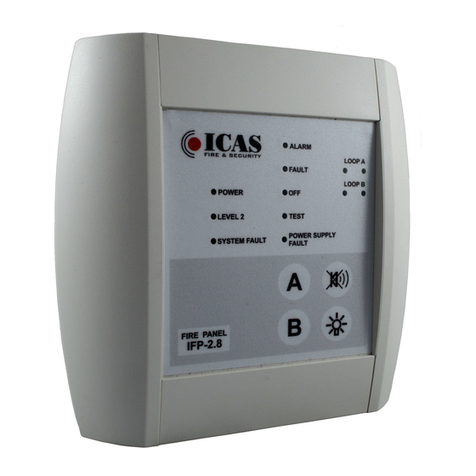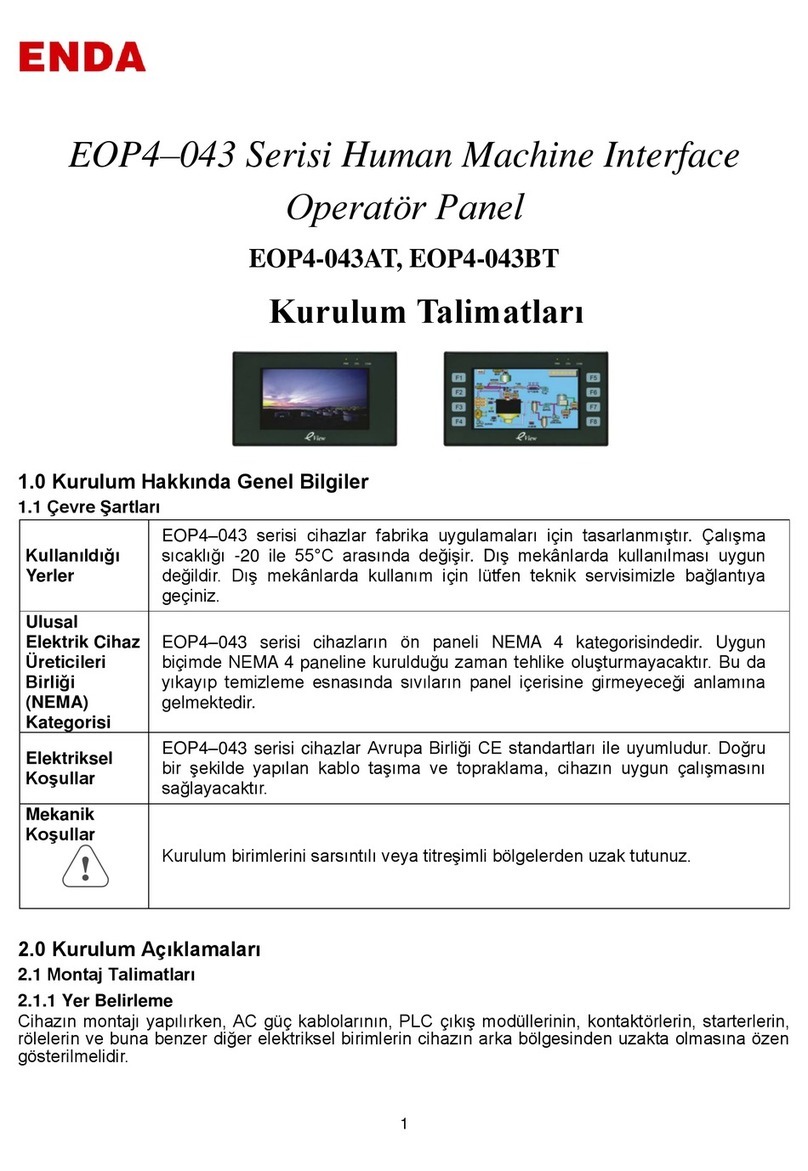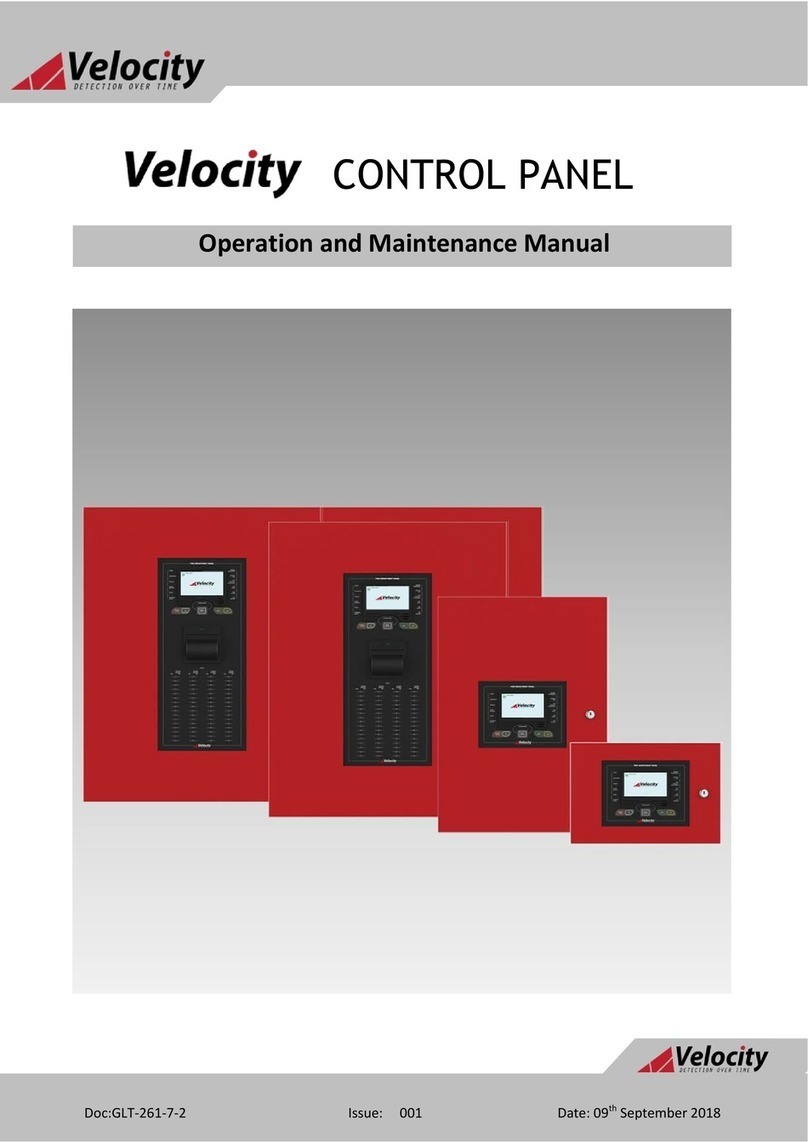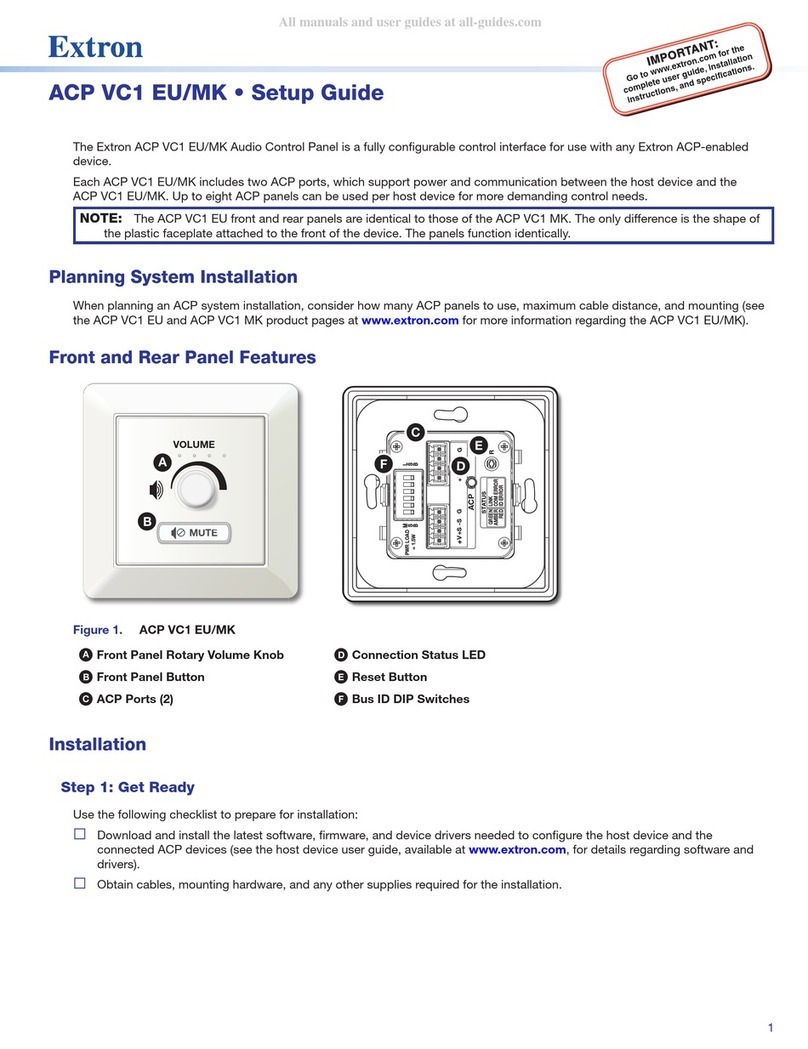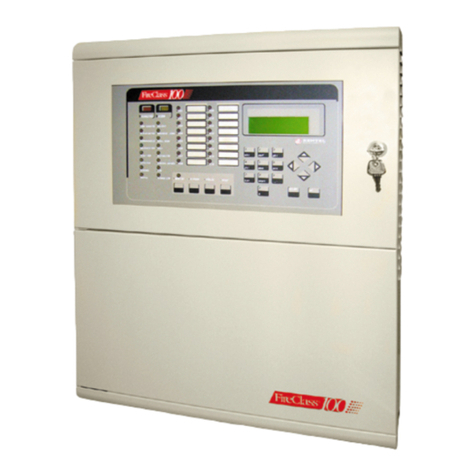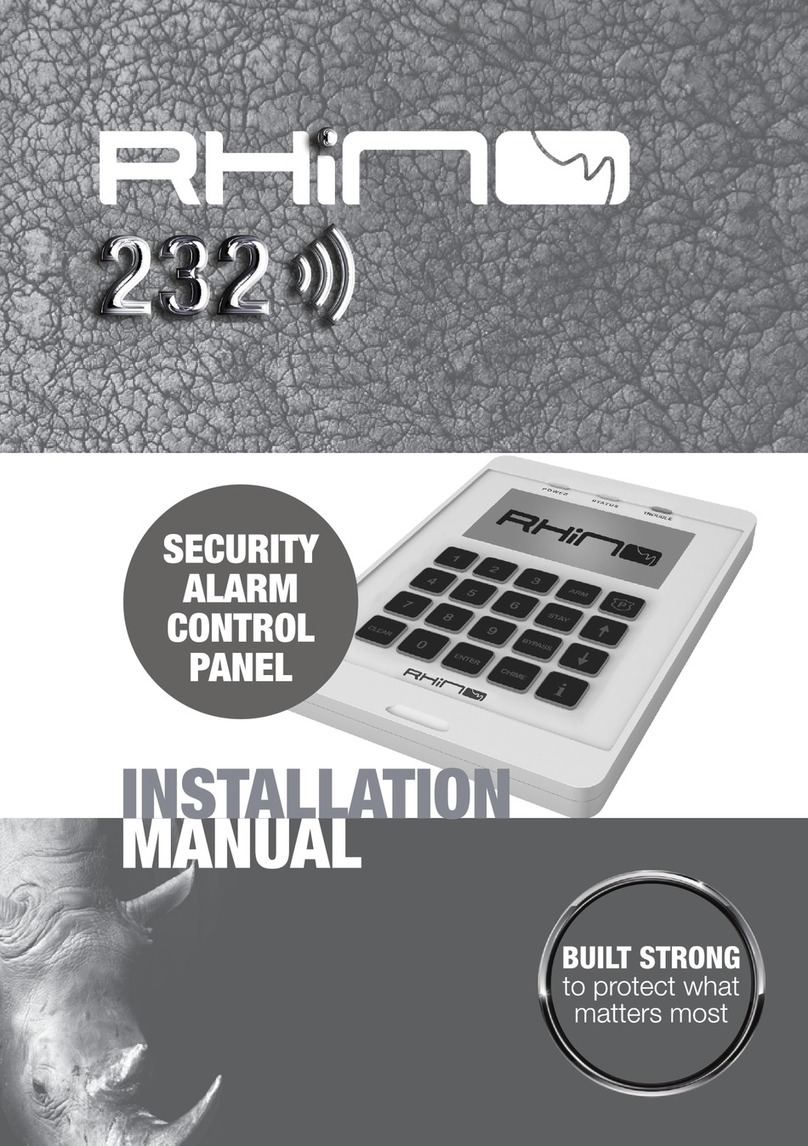Environment One E/One PLC User manual

E/ONE PLC
QUADPLEX PANEL
Installation and
Operation Manual
For Hardwired Pumps
Environment One Corporation

2 NA0702P01 REV A
12/03/2019
Contents
1 Overview ............................................................................................................................................................................................................................................3
2 E/One PLC Quadplex Menu Flowchart (Refer to section 5 for more info on these menus)................................................................................................................4
3 Wiring Instructions.............................................................................................................................................................................................................................5
4 Startup ...............................................................................................................................................................................................................................................5
5 User Menus and Touch Screen Interface ...........................................................................................................................................................................................6
5.1 Main Menu..............................................................................................................................................................................................................................6
5.2 Pump Data Menu ....................................................................................................................................................................................................................6
5.3 Active Alarm / Trouble Log ......................................................................................................................................................................................................7
5.4 Alarm History ..........................................................................................................................................................................................................................7
5.5 Set Points Menus.....................................................................................................................................................................................................................8
5.6 Options Menu .........................................................................................................................................................................................................................8
5.6.1 Voltage Data Menu.......................................................................................................................................................................................................8
6 System Parameters ............................................................................................................................................................................................................................9
6.1 Software Revision....................................................................................................................................................................................................................9
6.2 User Programmable Functions ................................................................................................................................................................................................9
6.2.1 Run Levels.....................................................................................................................................................................................................................9
6.2.2 Overpressure Current (High Amps) Setting ..................................................................................................................................................................9
6.2.3 Run Limit Setting ..........................................................................................................................................................................................................9
6.2.4 Cold Start......................................................................................................................................................................................................................9
6.2.5 Clear Trouble ................................................................................................................................................................................................................9
6.2.6 Restore Factory Defaults ..............................................................................................................................................................................................9
7 Normal Operation ............................................................................................................................................................................................................................10
7.1 Manual Run Operation ..........................................................................................................................................................................................................10
7.2 High Level Alarm Operation ..................................................................................................................................................................................................10
7.3 Audible Alarm Manual Silence...............................................................................................................................................................................................10
7.4 Pump Performance ...............................................................................................................................................................................................................10
7.4.1 Hour Meter (RUNTIME) ..............................................................................................................................................................................................10
7.4.2 Cycle Counter (CYCLES)...............................................................................................................................................................................................10
7.4.3 Last Cycle Runtime (LAST (s))......................................................................................................................................................................................11
7.4.4 Minimum Runtime (MIN RUN (s))...............................................................................................................................................................................11
7.4.5 Maximum Runtime (MAX RUN (s)) .............................................................................................................................................................................11
7.4.6 Average Runtime (AVG RUN (s)) .................................................................................................................................................................................11
7.4.7 Minimum Amps (MIN AMPS (A)) ................................................................................................................................................................................11
7.4.8 Maximum Amps (MAX AMPS (A))...............................................................................................................................................................................11
7.4.9 Average Amps (AVG AMPS (A))...................................................................................................................................................................................11
7.4.10 Minimum Volts (MIN VOLTS (VAC))............................................................................................................................................................................11
7.4.11 Maximum Volts (MAX VOLTS (VAC))...........................................................................................................................................................................11
7.4.12 Average Volts (AVG VOLTS (VAC)) ..............................................................................................................................................................................11
8 Trouble Operation............................................................................................................................................................................................................................11
8.1 Excessive Runtime Operation ................................................................................................................................................................................................11
8.2 Brownout Operation .............................................................................................................................................................................................................12
8.3 Overvoltage Operation..........................................................................................................................................................................................................12
8.4 Overpressure Operation........................................................................................................................................................................................................12
8.5 Comm Lost Indication............................................................................................................................................................................................................12
9 Diagnostics .......................................................................................................................................................................................................................................12
9.1 Alarm Test .............................................................................................................................................................................................................................12
10 Communication................................................................................................................................................................................................................................13
10.1 USB Interface.........................................................................................................................................................................................................................13
11 Trouble Shooting ..............................................................................................................................................................................................................................13
11.1 Troubleshooting Chart...........................................................................................................................................................................................................13
12 Appendix ..........................................................................................................................................................................................................................................15
12.1 Typical Field Wiring Diagram .................................................................................................................................................................................................15
12.2 Alarm Messages ....................................................................................................................................................................................................................16
12.3 Normal and Full Operational Ranges .....................................................................................................................................................................................16

3 NA0702P01 REV A
12/03/2019
1Overview
This manual provides information on the operation and use of Environment One PLC Quadplex Panels.If unsure of the
configuration of your panel, contact E/One factory for assistance.
The E/One PLC Quadplex panel is an Environment One full-featured Alarm/Monitor panel. The E/One PLC Quadplex
panel monitors for the following operating conditions:
•Pump Overpressure Condition – Pump operating at abnormally high current level
•Brownout Condition – Mains voltage 12% below nameplate rating
•Overvoltage Condition – Mains voltage 12% above nameplate rating
•High Liquid Level
•Low Liquid Level
•Real-time, High, and Low Voltage on the input
•Real-time and High current drawn by the Pump
•Pump failed to start
•Contactor fault
•Extended Pump Runtime
The E/One PLC Quadplex Panel displays pump status, operating parameters, and user options by means of the following
indicators:
•Touch Screen Interface to show Pump & Panel operating conditions & provide for interaction
In addition, the following pump operating parameters can be viewed from the E/One PLC Quadplex Panel:
•Real-time fluid level in tank
•Real-time pump Voltage and Amperage
•Cycles & Hours
•Latched fault conditions
The following features are field programmable:
•Run levels one through four
•Alarm Level
•Overpressure Current
•Extended Pump Runtime Limit
The following are the hardware features:
•IP65 / NEMA 4X Rated Enclosure
•Enclosure made from fiberglass
•Separate pump , control, and input Circuit Breakers
•Audible & Visual Alarm indicators (Silence for Audible Alarm)
•HAND / OFF / AUTO (HOA) switch for each pump (HAND = MANUAL RUN, OFF = PUMP WILL NOT RUN, AUTO =
PLC + PRESSURE TRANSDUCER CONTROL PUMP
•Touch screen interface
•Hinged aluminum deadfront
•Programmable Logic Controller (PLC)

4 NA0702P01 REV A
12/03/2019
Options Menu
Voltage Data Menu
Set Points Menu
Run Levels
Trouble Set Points
Active Alarm Log
Alarm History
Trouble Reset Menu
Main Menu
Pump 1 Data 1
Pump 2 Data 1
Pump 3 Data 1
Pump 4 Data 1
Pump 1 Data 2
Pump 2 Data 2
Pump 3 Data 2
Pump 4 Data 2
2E/One PLC Quadplex Menu Flowchart (Refer to section 5 for more info on these menus)
NOTE: VALUES SHOWN DO NOT REPRESENT ACTUAL
VALUES – REFER TO APPENDIX FOR EXPECTED VALUES.

5 NA0702P01 REV A
12/03/2019
3Wiring Instructions
WARNING – the E/One Alarm and Control panel is a high voltage system that controls power to an electric
motor(s). Care should be taken whenever performing service on the panel to avoid the risk of electrical shock
and/or damage to property. Because power may be supplied by multiple sources, circuit breakers alone may
not be sufficient to provide adequate protection.
The E/One PLC Quadplex panel wiring can change from model to model. All wiring shall be done in accordance with the
wiring decal on the inside cover of the panel enclosure. Typical wiring can be found in the Appendix of this manual.
4Startup
The E/One PLC Quadplex Panel should arrive from the factory ready to operate. The panel is properly installed and
started by following the steps below.
1. Mount and wire the panel per the instructions on the enclosure door.
2. Ensure that Pressure transducer in the station is set at the appropriate height (10” from the bottom of the tank).
If it is not, the off level will not be at the correct height, and the system may not function properly.
WARNING – Pressure transducer must have a range of 0-2.5m to ensure proper operation. If a different range is
used run levels will be improperly scaled.
3. ‘Cold Start’ the panel – refer to Cold Start section of this manual for more information.
4. Clear the Alarm History – Refer to the Alarm History Log section of this manual for more information.
5. If other than factory default settings are required, set all limits and levels. Factory defaults settings can also be
restored via the user menu. (Refer to the User Programmable Options section of this manual for more on this
feature).

6 NA0702P01 REV A
12/03/2019
5User Menus and Touch Screen Interface
The E/One Quadplex PLC panel includes a panel mounted touch screen interface to navigate the various menus and
select the user options (see Figures 2-8). The values displayed in the following figures are not realistic and are intended
to show only the number of digits that each field can contain. See appendix for the expected ranges of various values.
Refer to “System Parameters” section for definition of each field within the menus.
5.1 Main Menu
Real time panel voltage, Next to run (NTR) and real time fluid level in the tank are displayed on the main menu. Five
buttons on the main menu allow the user to access all of the functionality of the touch screen interface.
5.2 Pump Data Menu
The Pump Data menu allows the user to view pages of data for each pump. Each pump menu has two screens to display
amperage, total runtime, fluid level (inches), total cycles, min/max/average current, min/max/average runtime and last
runtime for that pump. Pump operational data may be reset on a screen by screen basis by holding the “RESET” button
for three seconds (Note that resetting the 1st screen of data will reset avg. cycle time (on screen 2), as it resets total
runtime and total cycles). Pump operational status will be indicated in the upper right, next to the arrow button
(Possibilities include “HAND”, “OFF”, “AUTO”, and “TRBL”). Data on additional pumps can be accessed via the left and
right arrow buttons.
Figure 3 – Pump Data Menu
Figure 2 – Main Menu

7 NA0702P01 REV A
12/03/2019
5.3 Active Alarm / Trouble Log
The Active Alarm Log shows any alarms / trouble conditions that are active in the station. This includes overpressure
(during the lockout period), overpressure final lockout, high level, low level, pump failed to start, contactor fault,
overvoltage, and brownout. It includes a time stamp and a description for each alarm / trouble condition. The log begins
with the most recent alarm / trouble condition, and lists them in reverse chronological order. Once a condition is
cleared, either manually (via pump trouble reset buttons) or automatically an entry will be added (highlighted in green)
showing the alarm was cleared with a timestamp. It will still exist in the alarm history (see section 5.4). The second
button from the right (ACK) will acknowledge an alarm, changing its status for awareness purposes. The arrow in the top
left will return the user to the Main Menu. The “Clear Trouble?” Button will open a menu where you can clear any
trouble conditions preventing a pump from running. This is especially useful for troubleshooting purposes.
5.4 Alarm History
The alarm history shows the last 100 alarms / trouble conditions detected by the panel, regardless of whether they have
been cleared manually or automatically. This includes overpressure (during the lockout period), overpressure final
lockout, high level, low level, pump failed to start, overvoltage, brownout, blocked line, contactor fault, and extended
pump runtime. It includes a time stamp and a description for each alarm / trouble condition. The log begins with the
most recent alarm / trouble condition, and lists them in reverse chronological order. Unlike the Active Alarm Log, events
will remain until the event limit is exceeded after which the oldest event will drop off when a new event is recorded. The
arrow button from the will return the user to the Main Menu.
Figure 4 – Active Alarm Log and Clear Trouble Menu
Figure 5 – Alarm History

8 NA0702P01 REV A
12/03/2019
5.5 Set Points Menus
Trouble Set Points and Run levels are accessed via the “Set Points” button in the Main Menu. Overpressure Amperage
and Run Limit may be edited via the trouble parameters panel. See sections 6.2.2 and 6.2.3 for more information
regarding these set points. Run levels 1-4 and the high level set point may be edited through the Run Levels menu. See
section 6.2.1 for more information regarding these set points. The arrows in the upper left will return the user to the
previous menu.
5.6 Options Menu
The options menu contains various options. The software version is displayed on this screen, and the user can access the
cold start and factory default options from this menu. In order to use these functions the buttons must be held for at
least 3 seconds (this is to prevent accidental deletion of operational data). See sections 6.2.4 and 6.2.6 for more
information regarding these options. The alarm light and buzzer can also be tested via this menu by simply holding the
respective button.
5.6.1 Voltage Data Menu
The Voltage Data Menu shows min/max/average voltages and overvoltage and brownout set points. These set points
are not editable. The min/max/average values may be reset by holding the “reset” button on the left for at least 3
seconds. The Voltage Data Menu is accessed via the options menu.
Figure 6 – Run Levels and Trouble Set Point Menus
Figure 7 – Options menu
Figure 7 – Options Menu
Figure 8 – Voltage Data Menu

9 NA0702P01 REV A
12/03/2019
6System Parameters
A number of system settings, some of which will be unique to the installation, can be set on-site. All of these settings
can be found within sub-menus in the Touch Screen Interface.
6.1 Software Revision
This read only field displays the revision of the software currently loaded into the panel. This information may be
required when speaking with E/One service personnel. This information can be found in the options menu.
6.2 User Programmable Functions
The following items can be used for system setup. In a Quadplex system all of these parameters are shared between the
4 pumps and cannot be set independently for each pump. Clearing of these values is also universal and affects all
pumps simultaneously.
6.2.1 Run Levels
Run levels 1-4 and the high level set point may be edited through the Run Levels Menu under the Set Points menu.
Simply press the correct set point value and a keyboard will appear allowing you to enter a new value (Note that off and
low level are not editable as they are based on the E/One pumps’ physical characteristics). For normal operation, the run
levels and alarm level must be set such that Off < Run 1 < Run 2 < Run 3 < Run 4 < High. This ensures that all pumps have
an opportunity to turn on before alarm is reached and that the sequencing works as intended. The Touch screen
interface will prevent the user from entering values which do not satisfy this criteria.
6.2.2 Overpressure Current (High Amps) Setting
This field displays the limit that is currently set for the Overpressure / High current protection feature. Though it is
possible to change this setting, it is not advised unless directed by E/One service personnel, as changing this limit will
affect how the overpressure protection feature performs. Doing so without proper guidance may void the product
warranty and can cause damage to the system.
6.2.3 Run Limit Setting
The Run Limit option is a user editable feature that can be set from the Trouble set points Menu. The factory default
setting for this feature is 10 minutes. This feature will cause a trouble alarm to be activated if an individual pump run
cycle exceeds the set value.
6.2.4 Cold Start
The Cold Start option is found within the Options menu. In order to cold start the panel the button must be held for a
minimum of 3 seconds. Cold Starting the panel erases all stored operating parameters listed within the Pump
Performance section (Section 7.4), and should be done when the panel is first installed. All previously stored operating
parameters will be cleared.
6.2.5 Clear Trouble
The Reset menu accessed from the active alarm log allows the user to manually clear trouble conditions for one or all
pumps. This is intended to be used for troubleshooting purposes after a pump has been locked out. If the trouble
condition persists, the pump will be locked out again on the next run. A successful, trouble free 5-second manual or
automatic run will also clear certain trouble conditions.
6.2.6 Restore Factory Defaults
The Restore Factory Defaults function will restore all set points and limits to factory original. This functionality is
accessed through the Options Menu. In order to restore factory defaults the button must be held for a minimum of 3
seconds. Restoring the factory default values returns the following fields to their factory preset conditions as follows:
Overpressure Limit [12.5 A], Run Limit [10 MINUTES], Run Levels 1,2,3,4,High [16, 18, 20, 22, 26].

10 NA0702P01 REV A
12/03/2019
7Normal Operation
Under normal operating conditions, the E/One PLC Quadplex panel will perform as follows when power is applied:
1. During the boot-up period, all panel indications and outputs will be OFF.
During this boot up sequence, all operating parameters are recovered from non-volatile memory. If this is the
first time the panel has been started, these will be the factory defaults and all operating parameters will be 0.
Otherwise, these values will be what they were the last time the panel operated. If the panel requires a reset to
restore factory defaults, refer to the Restore Factory Defaults feature in the User Programmable Functions
section (Section 6.2) of this manual.In addition, a Cold Start may be needed to clear out the Pump Performance
operating parameters; refer to the Cold Start feature within the user programmable functions section of this
manual.
2. Under normal conditions, the Touch Screen Interface will display the real-time Panel Voltage, Station Fluid level,
and NTR at all times.
3. After each completed pump run cycle, the Pump data screens are updated to reflect the most current data.
Refer to the Pump Performance section of this manual for more on this feature.
7.1 Manual Run Operation
The lead pump can be operated manually by pressing and holding the HOA switch on the dead-front in the Manual Run
position (Labelled on deadfront). The pump will run and all the operational data associated with it will be available on
its data screen. The Manual Run feature is capable of bypassing trouble conditions – it should be used with caution in
cases where overpressure or overvoltage / brownout are a factor. Releasing the switch will stop the pump. Each pump
can be operated individually by using its own HOA switch.
7.2 High Level Alarm Operation
A High Level Alarm is initiated if the liquid level in the tank reaches the high level as determined by the Pressure
Transducer or backup high level float. If a High Level is detected, the panel will energize the contactors for all 4 pumps
(if they are not already energized), and turn on the alarm light and buzzer. This condition will remain until the 4 pumps
have pumped the station below 2 inches below the alarm level. This is the most critical alarm condition as it indicates
that the pumps cannot keep up with inflow or the pressure transducer is malfunctioning.
7.3 Audible Alarm Manual Silence
Any time the audible alarm / buzzer is activated by the system, and the PLC is functioning, it can be silenced by pressing
the ‘SILENCE’ button located on the exterior underside of the enclosure. If the buzzer has been activated due to a PLC
failure then the Alarm Breaker must be switched off to silence the buzzer.
7.4 Pump Performance
Pressing the Pump Data button on the main menu will display data for each pump e.g. runtime / total cycles. All
parameters are non-volatile (retained through a power loss), unless otherwise stated. Pressing the Voltage Data button
on the Options Menu will display mains voltage data e.g min/max/average voltage. The following values are displayed
on the Pump Data and Voltage Data menus.
7.4.1 Hour Meter (RUNTIME)
Accumulated runtime - The time is displayed as Runtime: HH:MM:SS, where HH are the total hours, MM minutes, and
SS seconds since the last reset. The maximum runtime value that can be stored is 99999:59:59 (> 11 years). Beyond this
limit the value displays as 99999:MM:SS (minutes and seconds will continue to cycle but hours will display as 99999).
7.4.2 Cycle Counter (CYCLES)
Accumulated cycles - The value is displayed as Cycles: XX, where XX are the total accumulated pump cycles since the last
reset. The maximum cycle value that can be displayed is 9999999.Beyond this limit the value displays as 9999999 until
reset to 0 by the user.

11 NA0702P01 REV A
12/03/2019
7.4.3 Last Cycle Runtime (LAST (s))
Last runtime represents the duration of the previous completed pump cycle. This value is displayed as LAST (s): XXs,
where XX is the last runtime duration in seconds. This parameter is not saved through power loss.
7.4.4 Minimum Runtime (MIN RUN (s))
The minimum runtime represents the duration of the shortest completed pump cycle since the last reset. This value is
displayed as MIN RUN (s): XXXs, where XXX is the minimum runtime duration in seconds.
7.4.5 Maximum Runtime (MAX RUN (s))
The maximum runtime represents the duration of the longest completed pump cycle since the last reset. This value is
displayed as MAX RUN (s): HH:MM:SS and has the same limits as the normal hours.
7.4.6 Average Runtime (AVG RUN (s))
The average runtime represents the duration of the average completed pump cycle since the last reset. This value is
displayed as AVG RUN (s): XXXs where XXX is the average runtime duration in seconds.
7.4.7 Minimum Amps (MIN AMPS (A))
The minimum Amperage reading represents the minimum amperage draw the motor has experienced while running
since the last reset. This value is displayed as MIN AMPS (A):X.XA where X.X is the minimum Amperage to the nearest
tenth. This parameter is not saved through power loss.
7.4.8 Maximum Amps (MAX AMPS (A))
The maximum Amperage reading represents the maximum amperage draw the motor has experienced while running
since the last reset. This value is displayed as MAX AMPS (A): X.XA where X.X is the maximum Amperage to the nearest
tenth. This parameter is not saved through power loss.
7.4.9 Average Amps (AVG AMPS (A))
The average Amperage reading represents the average amperage draw the motor has experienced while running since
the last reset. This value is displayed as AVG AMPS (A): X.XA where X.X is the average Amperage to the nearest tenth.
This parameter is not saved through power loss.
7.4.10 Minimum Volts (MIN VOLTS (VAC))
The minimum Voltage reading represents the minimum voltage the motor has experienced while running since the last
reset. This value is displayed as MIN VOLTS (VAC): XV where X is the minimum Voltage to the nearest volt. This
parameter is not saved through power loss.
7.4.11 Maximum Volts (MAX VOLTS (VAC))
The maximum Voltage reading represents the maximum voltage the motor has experienced while running since the last
reset. This value is displayed as MAX VOLTS (VAC): XV where X is the maximum Voltage to the nearest volt. This
parameter is not saved through power loss.
7.4.12 Average Volts (AVG VOLTS (VAC))
The average Voltage reading represents the average voltage the motor has experienced while running since the last
reset. This value is displayed as AVG VOLTS (VAC): XV where X is the average Voltage to the nearest volt. This
parameter is not saved through power loss.
8Trouble Operation
Several less serious operating conditions can be detected and indicated to warn of pending, more serious faults. These
conditions do not warrant an immediate response and may clear themselves given time.
8.1 Excessive Runtime Operation
Excessive Runtime is a trouble condition that is initiated if an individual pump run cycle exceeds the set Run Limit value.
If the Run Limit is exceeded, the alarm history will show a run limit exceeded trouble condition. Pump operation will be
unaffected.

12 NA0702P01 REV A
12/03/2019
8.2 Brownout Operation
Brownout is a motor protection feature that will disable power to the motor if the incoming AC Mains Voltage is below a
predefined limit, typically 12% of the nominal nameplate rating. In the brownout mode, the pumps are prevented from
starting (if the pump is off), or is shut off (if the pump is running) until the voltage returns to within the desired range of
operation, typically 10% of the nominal nameplate rating. When in the Brownout Protection mode, the panel will
disable power to the pumps, whether the motor is running or not and indicate a trouble condition.
8.3 Overvoltage Operation
Overvoltage is a motor protection feature that will disable power to the motor if the incoming AC Mains Voltage is
above a predefined limit, typically 12% of the nominal nameplate rating. In the Overvoltage mode, the pump is
prevented from starting (if the pump is off), or is shut off (if the pump is running) until the voltage returns to within the
desired range of operation, typically 10% of the nominal nameplate rating. When in the Overvoltage Protection mode,
the panel will disable power to the pumps, whether the motor is running or not and indicate a trouble condition.
8.4 Overpressure Operation
Overpressure is a motor protection feature that will disable power to the motor if the amperage rises above a
predefined limit. Refer to the Trouble menu within the Set Points menu to see what the current value for this setting is.
This limit can be changed under direction of the factory to accommodate various system variables. When an
Overpressure condition is detected, the pump is shut off and a 20 minute lockout period begins. During this time, the
Overpressure condition is logged on the Touch Screen Interface and the pump is not allowed to run regardless of the
liquid level in the tank. After the 20 minute lockout, the pump is allowed to run; if the Overpressure condition is still
present a second lockout period begins, and the cycle will repeat. During the first three lockout periods, the panel alarm
light will be lit. If after the third lockout period (60 minutes) the condition has not been removed and the pump
attempts to start, the panel will indicate an alarm condition including the Alarm Lamp and Audible Alarm. After the third
failed retry, the pump is disabled indefinitely until it can be serviced. In an Overpressure condition, the 20 minute
lockout period can be bypassed by pressing the Reset Button for the effected pump. This should only be performed by
E/One Certified Service Personnel. If all pumps are locked out due to overpressure at the same time, the panel will
indicate a “Blocked Line” alarm and display visual and audible alarms. See section 8.5 for more information on the
blocked line condition.
8.5 Blocked Line Operation
If all pumps are locked out due to overpressure at the same time, the panel will indicate a “Blocked Line” alarm and
display visual and audible alarms. This is a critical trouble condition as it means a high level alarm is inevitable. The most
likely cause of a blocked line condition is a blockage in the discharge line or the main, which is causing all pumps in the
station to experience overpressure conditions.
8.6 Comm Lost Indication
This error indicates that the communication link between the PLC and Touch screen interface which make up the E/One
Sentry PLC Quadplex Panel is not functioning properly. In this situation, the touch screen will not display any live
information (only alarm history up to point of disconnection) but the PLC which controls the pumps will function
normally. If this condition is present, check the Ethernet cable that connects the two devices, and ensure the PLC is
functioning properly.
9Diagnostics
The interface allows the user to test both alarm outputs, buzzer and alarm light via buttons on the options menu.
9.1 Alarm Test
This test is intended to prove functionality of audible and visual alarm. Holding the button (s) will energize the alarm
light and/or the buzzer. If either do not turn on when the test is performed, the panel should be serviced.

13 NA0702P01 REV A
12/03/2019
10 Communication
The E/One PLC Quadplex Panel can be read by an external device to provide system operating parameters for system
monitoring and predictive maintenance.
10.1 USB Interface
All PLCs can be connected to a laptop or desktop computer in order to read all system variables and configuration data.
Using the free software, Somachine Basic v1.6 from Schneider Electric, the user can read in all data (even that which is
not visible via the Touch Screen Interface) and troubleshoot in more depth.
11 Trouble Shooting
The following chart is meant to address some common panel related issues. For more detailed information or pump
specific troubleshooting, please refer to the appropriate Service Manual or contact E/One service personnel.
11.1 Troubleshooting Chart
Fault Symptom Possible Cause Test
Brownout
Voltage being
measured by PLC is
too low
Low incoming voltage
•This testing may need to be done by qualified personal
•
Check voltage at panel per manual
Blown fuse or circuit
breaker
•Verify all fuses or breakers feeding the panel are on (closed)
Malfunctioning voltage
transducer
•Verify that the voltage transducer is functioning properly
Excessive heat in panel
•Verify outside air temperature is below 120 F to ensure proper analog
input operation
Overvoltage
Voltage being
measured by PLC is
too high
High incoming voltage
•This testing may need to be done by qualified personal
•Check voltage at panel per manual
Malfunctioning voltage
transducer
•Verify that the voltage transducer is functioning properly
Excessive heat in panel
•Verify outside air temperature is below 120 F to ensure proper analog
input operation
Overpressure Excessive pump
pressure
Discharge valve closed,
check valve malfunction,
line restriction, grinder
restriction, bad motor
•Remove pump from discharge and retest with no discharge (pump
back into station)
If problem is still present then refer to Service Manual for more testing
Run Limit Pump running longer
then set time
Tank size too large, stator
worn, high in-flow
•Check amperage
•Change Excessive Run Time Limit
No pump via
pressure
transducer
Pump will not run on
own but will run in
manual run
Pressure Transducer not
working, Tank ventilation
blocked trouble condition
present.
•Perform continuity test per Service Manual to determine if the
Transducer is faulty
•Verify that the tank ventilation is clear
Panel will not
power up
Touch screen display
will not power up
Touch screen display not
plugged in or properly, no
power to the PLC, faulty
display, faulty PLC
•Check to see that the display and PLC are plugged in properly, if this
still does not fix try another display
•Check that wiring is correct per wiring schematic
•Check between neutral and both sides of the alarm breaker for 120v
to determine if it is bad
Contactor in
panel will not
engage
Pump will not run No power to contactor coil,
contactor bad
•Check voltage at A1 to A2 coil on contractor
•Check continuity on contactor coil
•
Check for faulty contactor trouble condition
Contactor in
panel engages
but pump will
not run
Pump will not run
No power coming out of
contactor, loose wires,
pump not working
•Check for power across L1 & L2 (L1 & N) to see if power is going into
the contactor, if no power then check incoming and breaker
•Then check T1 & T2 to see if it is going through the contactor, if not
then replace the contactor
•Check voltage at the terminal block to see if power is there
•If all this is ok then refer to Service Manual for trouble shooting the
pump

14 NA0702P01 REV A
12/03/2019
Fault Symptom Possible Cause Test
Panel does not
protect against
fault conditions
No trouble faults,
pump is not disabled
for Brownout,
Overvoltage,
Overpressure, etc…
panel contactor not
functioning, panel
contactor mis-wired, faulty
PLC, set points not properly
entered
•Verify contactors are open when pumps not called to run by PLC
Manual run not
working
Manual run does not
make pump run
Panel mis-wired, faulty
HOA switch, faulty
contactor
•Check wiring of panel, all wires need to be per wiring instruction

15 NA0702P01 REV A
12/03/2019
12 Appendix
12.1 Typical Field Wiring Diagram

16 NA0702P01 REV A
12/03/2019
12.2 Alarm Messages
The following messages may be displayed on the touch screen interface in the active alarm log or alarm history to
indicate various system conditions.
•HIGH FLUID LEVEL – indicates a high level is present per high level float or transducer
•LOW FLUID LEVEL – indicates a low level is present per low level float or transducer
•LOW VOLTAGE – indicates the AC mains voltage feeding a pump is below the minimum limit
•HIGH VOLTAGE – indicates the AC mains voltage feeding a pump is above the maximum limit
•P1/2/3/4 OVERPRESSURE – indicates a pumps current draw is above the maximum limit
•P1/2/3/4 OP PERMALOCK – indicates a pump has been locked out due to repeated overpressure states
•P1/2/3/4 RUN LIMIT – indicates a pump runtime has exceeded the limit set under the Run Limit setting
•BLOCKED LINE – indicates that all pumps are locked out due to overpressure conditions
•P1/2/3/4 FAILED TO START – indicates that a pump failed to start when called to run by the PLC
•C1/2/3/4 FAULT – indicates that a contactor failed to close when called by the PLC, or failed to open when not
called by the PLC, and not being manually run.
12.3 Normal and Full Operational Ranges
The following list includes the typical operating ranges and measurable ranges for all variables that are displayed via the
touch screen interface.
•Voltage: Expected range:230VAC – 250VAC / Measurable Range: 0VAC - 300VAC
•Current: Expected Range (during operation): 5-10A / Measurable Range: 0-20A PER PUMP
•Fluid Level: Expected Range: 12”-26” / Measurable Range: 10-72” (Below 10” displays as 10”)
•Runtime: Expected Range: 0-99999 H / Recordable Range: N/A
•Cycles: Expected Range: 0-1000000 cycles / Measurable Range: N/A
•Cycle time (min/max/average/last Run): Expected Range: 0-300s / Measurable Range: 0 -9999s

17 NA0702P01 REV A
12/03/2019
Environment One Corporation
2773 Balltown Road
Niskayuna, New York 12309–1090
Voice: (01) 518.346.6161
Fax: 518.346.6188
www.eone.com
A Precision Castparts Company
Table of contents
Popular Control Panel manuals by other brands

Bentel Security
Bentel Security FireClass FC500IP installation manual
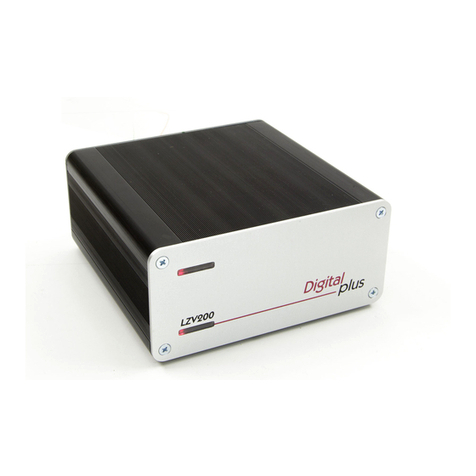
Lenz
Lenz Digital Plus LZV200 operating manual

urmet domus
urmet domus ELKRON DK500M-P Guide
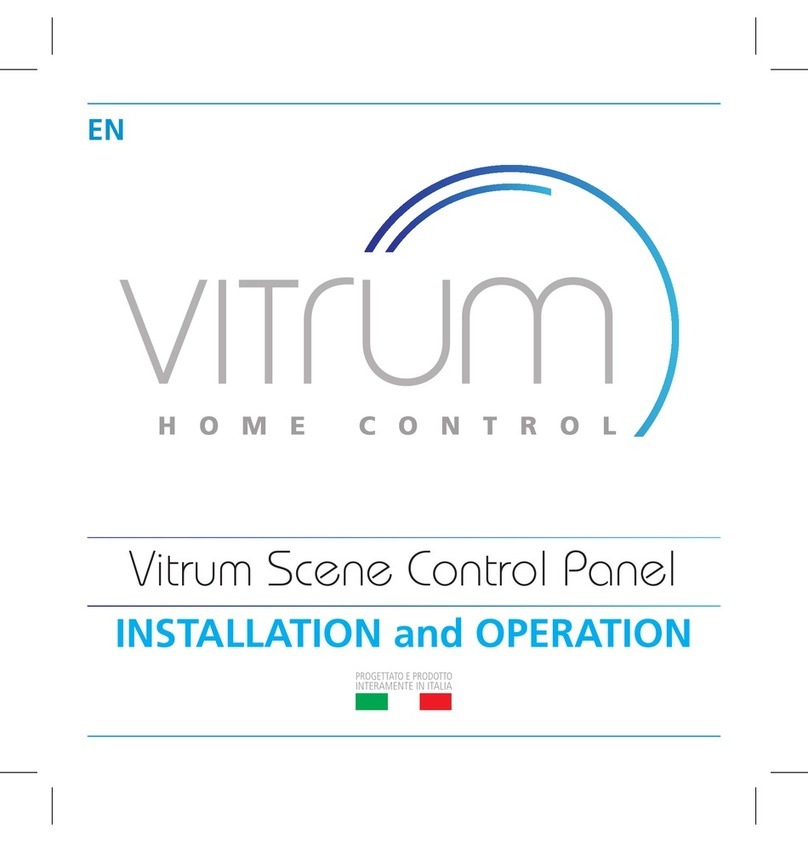
Vitrum
Vitrum Scene Installation and operation
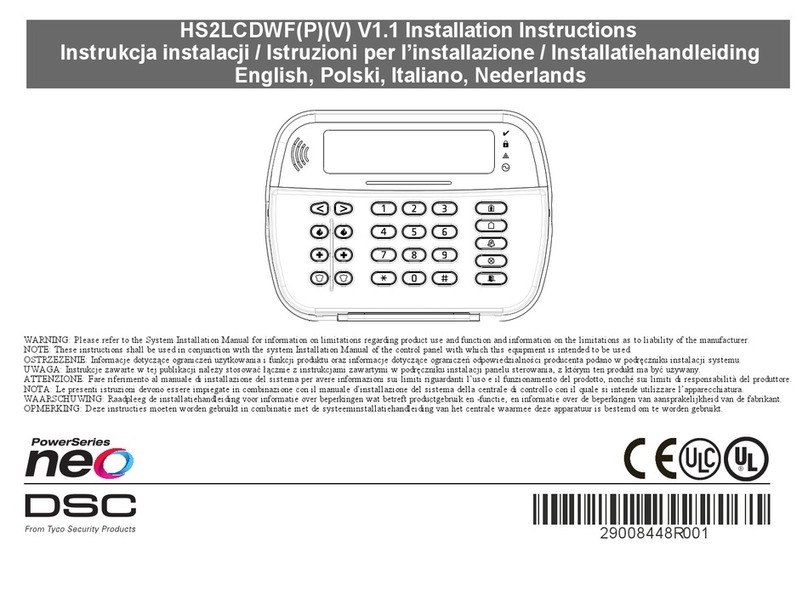
DSC
DSC PowerSeries Neo installation instructions

ADEMCO
ADEMCO LST700 Series Insallation & maintenance manual
